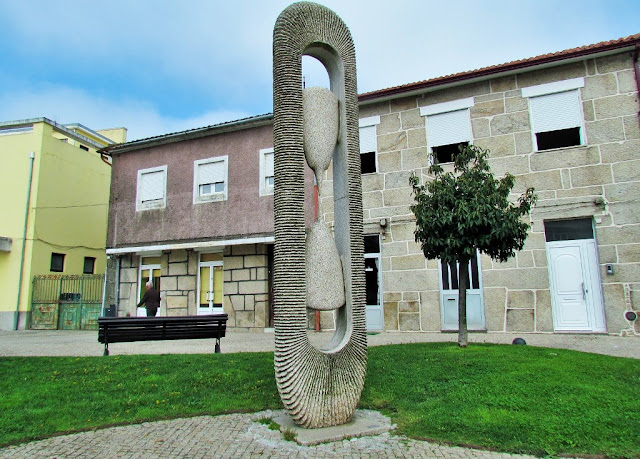VILA POUCA DE AGUIAR
GPS: N 41.50313; W 7.64122
It is the seat of a municipality with an area of 437.07 km² [1] and 13 187 inhabitants (2011), subdivided into 14 parishes. The municipality is limited to the north by Chaves, to the east by Valpaços and Murça, to the south by Alijó, Sabrosa, and Vila Real, to the west by Ribeira de Pena, and the northwest by Boticas.
economy
The products that move millions of euros in the economy of Vila Pouca de Aguiar are the chestnut, the mushroom, and the kid.
The municipality has a chestnut production of around 1,000 tons, with around 2 million euros in income. There are about 300 to 400 families in the municipality who earn income from the chestnut. The municipality is located in the Protected Designation of Origin (PDO) area of Padrela.
In Vila Pouca de Aguiar mushrooms are also an expanding sector. The harvest moves hundreds of people, some of whom are only for their own consumption, but a significant percentage also collect for marketing, which represents an income complementary to the family budget.
Around the county, there are still about five
**********************
AGUIAR DA PENA CASTLE
41°28′10.1″N 7°40′48.4″W
The Castle of Pena de Aguiar (Castelo de Pena de Aguiar) is a medieval castle, alternately the Castle of Aguiar da Pena, situated in the civil parish of Telões, in the municipality of Vila Pouca de Aguiar, in the Portuguese district of Vila Real.
History
In the first century B.C. a Roman military fort was constructed to overlook the important roadway between Aquas Flavias (Chaves) and Lamecum (Lamego). At that time, the Romans were attracted to the region due to the presence of gold ore, silver and lead. In the following centuries, the region was successively occupied by Visigoths and Muslims until the eighth century.
By the 11th century, following the Christian Reconquista of the territory, the Kings of León recovered and restructured the former Visigothic administrative center. There are references to the conquest of the region by troops of Ferdinand I of León. At that time the countships of the region were reestablished, resulting in the construction of fortified residences that served as shelters and residences for the masters of the land.
Medieval
Between the beginning of the 12th century and 13th century, the castle of Aguiar was constructed, and likely completed during the reign of Sancho I. At this time, the "castle" was an important strategic point in the Terra de Aguiar (the nucleus of municipality of Vila Pouca de Aguiar) and inhabited by partisans of D. Afonso Henriques (1112–1185), later referenced in medieval Hagiography in Santa Senhorinha de Basto. For this reason, the region was invaded and the Castle of Aguiar besieged by Leonese forces, that were charged with bringing the region to heal or imprisoning the supporters of Afonso Henriques. An important event in the independence of Portugal, it was D. Gonçalo Mendes de Sousas, master of the dominions of Aguair and Panóis, and man-at-arms of the nascent King who quickly hastened to give aid to the forces at Pena de Aguiar.
Later, during the reign of King D. Afonso III (1248–1279), the parish of Telões received its first Carta de Foral (Foral charter) on 10 July 1255. At this time, though, the fortification had already begun to lose its strategic importance, and following 1258, the population began to gradually abandon the maintenance of the defensive line.
At the end of the 14th century, there were works completed in the barbican and the embrasure hall; it is unclear whether the public works were destined to the castle's consolidation or from repairs. By the beginning of the 16th century, the village of Telões lost its administrative importance, and was integrated into the foral associated with Aguiar da Pena in 1515. Ironically, it was during this time that more information on the castle alcaldes were specified, including: Diogo Lopes de Azevedo; Fernão Martins de Souza (from 17 July 1534); João de Souza Guedes; and Jerónimo de Souza Machado (1583–1594).
The structure was finally abandoned in 1527, due to a progressive change in warfare dependent on gunpowder.
On a 28 December 1804 report, there is evidence that the Province of Trás-os-Montes was unprotected, without fort or military fortifications, during the Spanish invasion of 1762, resulting in the assault of Chaves, Bragança and Miranda, and attacks on castles in the region. A circular was issued on 23 September 1861, restating the problems that existed in the northern defences, from the Ministro da Guerra (Minister of War) referring to the fortifications of the province.
💓💓💓💓💓
SEARCH IN ALPHABETICAL ORDER IN
THE DISTRICT OF VILA REAL.
💓💓💓💓💓
Return to mainland Portugal &
the Azores and Madeira islands































